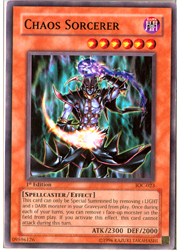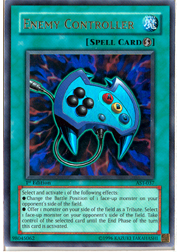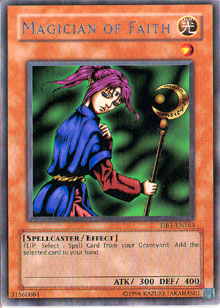Here at Metagame.com, I always enjoy encouraging any deck that features the right combination of impossible, original, and workable. We’ll have to expand our definition of Chaos in the new format. I plan to call any deck that uses at least two copies of Chaos Sorcerer, one of the best cards in the new format, a “Chaos Deck.” This begs the question—does Chaos Sorcerer have a powerful enough effect to warrant including it as the centerpiece of a deck? It’s time for some comparison shopping.
Chaos Sorcerer: Envoy to the Envoy of the Beginning
 Chaos Sorcerer is obviously not as good as Black Luster Soldier, but it can actually generate just as much advantage. Black Luster Soldier had a subtle power that duelists didn’t always realize. It created an automatic two-for-one trade because of its powerful ATK value, assuming that you used it correctly. After summoning it to remove an opponent’s monster (provided that he or she didn’t have a Torrential Tribute to trigger) it instantly removed your opponent’s resource. At that point, because of its ATK value of 3000, the opponent still had to use a spell or trap to destroy it, creating a two-for-one resource trade. Now obviously, Black Luster Soldier could bring even more into the equation, including huge life point swings of 4000 or more and removing an entire board (under a Thousand-Eyes Restrict lock, for example).
Chaos Sorcerer is obviously not as good as Black Luster Soldier, but it can actually generate just as much advantage. Black Luster Soldier had a subtle power that duelists didn’t always realize. It created an automatic two-for-one trade because of its powerful ATK value, assuming that you used it correctly. After summoning it to remove an opponent’s monster (provided that he or she didn’t have a Torrential Tribute to trigger) it instantly removed your opponent’s resource. At that point, because of its ATK value of 3000, the opponent still had to use a spell or trap to destroy it, creating a two-for-one resource trade. Now obviously, Black Luster Soldier could bring even more into the equation, including huge life point swings of 4000 or more and removing an entire board (under a Thousand-Eyes Restrict lock, for example).
Enter Chaos Sorcerer, a monster with a smaller ATK value and a more restricted effect, but one that still packs the ability to grab easy two-for-one trades. The optimal way to use it is to summon it and then remove a troublesome monster like D. D. Assailant, Injection Fairy Lily, or any monster with an ATK value of 2400. At that point, your opponent will either have to revive a tribute monster in the graveyard, set a monster, or use a spell or trap to destroy it. Voila! An instant two-for-one trade!
Of course, Chaos Sorcerer has a problem with face-down monsters, but even in those cases it’ll either destroy the monster outright or trade with it. Trading with a face-down monster is excellent if Chaos Sorcerer has already removed a monster from play, because once again it’ll generate a two-for-one resource swing. This concept is very important to the game, and you should always keep it in mind, regardless of whether you’re a beginner or an expert.
In this format, any card that can create a two-for-one trade by itself (such as Torrential Tribute, Dark Hole, Soul Exchange, and others) deserves to be placed into a deck. According to this criterion, Chaos Sorcerer definitely deserves to have a deck built around it. The stigma of running cookie-cutter Chaos is gone now, so it’s time for us to revive a legend.
Maximizing the Value of Your New $1.00 Purchase!
Chaos Sorcerer has great synergies with a number of cards that help it circumvent the fact that it loses a battle phase after using its removing-from-play effect.
1. Use it as tribute fodder for a monster.
What do cards like Apprentice Magician, Mystic Tomato, Snatch Steal, and Soul Exchange have in common? They allow you to tribute a monster for either a free cost or at a cost to your opponent! In most of these cases, your opponent loses a monster while you gain the tribute monster and its summoned effect.
Chaos Sorcerer is another example of this. Use its effect to remove a monster, then tribute it for any of the Monarch monsters. You not only get a free tribute (because Sorcerer is a special summon), you take away the opponent’s monster, get the Monarch’s effect, and get a 2400 ATK monstrosity on the field! This “remove, then tribute” play is great with almost any of your favorite tribute monsters. It helps create synergies with tribute monster strategies by providing yet another way to get around the “one normal summon per turn” restriction.
2. Use it as tribute fodder for a spell or trap effect.
 You can stack even more on top of this strategy with cards like Enemy Controller. Summon Chaos Sorcerer, remove an opponent’s monster, use Enemy Controller to sacrifice your now-spent Sorcerer to take the opponent’s other monster, and then finally tribute that monster for a thrilling combo!
You can stack even more on top of this strategy with cards like Enemy Controller. Summon Chaos Sorcerer, remove an opponent’s monster, use Enemy Controller to sacrifice your now-spent Sorcerer to take the opponent’s other monster, and then finally tribute that monster for a thrilling combo!
How about Metamorphosis? In this format, you can remove a monster, morph for Ryu Senshi, and have nothing to fear. That’s almost a guaranteed 2000 points of damage, since Ryu Senshi can’t be targeted by spells. There are many more examples of cards that help Chaos Sorcerer, including Book of Moon and Tsukuyomi. Any new Chaos deck should seek to take advantage of all of these!
3. Use its threatening presence to your advantage.
After a certain point, if you let Chaos Sorcerer remain on the field, your opponent will be forced to either continually set a monster or use a trap to defend his or her life points. This is where face-down removal comes in! Use Drillroid or Mystic Swordsman LV2 to immediately punish your opponent for his or her turtle-in-the-shell strategy.
Alternately, you can use cards like Ceasefire and Swords of Revealing Light to take advantage of the opponent’s false sense of security. You can flip his or her monster up, remove it from the game, then use a card like Tsukuyomi to still have a battle phase! Yes, you heard me correctly. Flipping the Sorcerer face-down resets any conditions placed upon it, just like Black Luster Soldier.
A Key Fact to Remember
It would be one thing to try and create a Chaos deck if Light and Dark monsters were in short supply, but that’s not the case in the new Advanced format. Remember that Light and Dark still remain the best monster types in the game, and the recent release of Cyber Dragon makes the once-scarce Light monster even easier to find! Here’s a sample monster lineup.
2 Chaos Sorcerer
1 Jinzo
1 Mobius the Frost Monarch
3 Cyber Dragon
1 Breaker the Magical Warrior
1 Sangan
1 Magician of Faith
1 Tsukuyomi
2 Apprentice Magician
1 Old Vindictive Magician
1 D.D. Warrior Lady
1 D.D. Survivor
1 Cyber Jar
1 Magical Merchant
See how none of the monster choices appear forced? The Chaos Sorcerer strategy is augmented by wise Dark and Light monster choices, which enables you to get tons of utility out of your spell and trap support.
 Copies of Magical Merchant and Magician of Faith, mixed with your multitude of special summons, enable you to get full use out of Metamorphosis. This helps your sole copy of Scapegoat even more, since you can use copies of cards like Enemy Controller for even more utility.
Copies of Magical Merchant and Magician of Faith, mixed with your multitude of special summons, enable you to get full use out of Metamorphosis. This helps your sole copy of Scapegoat even more, since you can use copies of cards like Enemy Controller for even more utility.
The speed that Apprentice Magician adds to the deck enables you to create basic Tsukuyomi locks that are not as effective as they used to be, but still provide great power in a format that’s lacking swift resource replacements. The rest of the deck is pretty self-explanatory, but this is just a small example of a type of deck where Chaos Sorcerer can shine.
You can always experiment with other monster lineups that include multiple copies of Magical Merchant, or try some alternate routes with venerable stalwarts like Airknight Parshath and Blade Knight. The major bottleneck at this point is your choice of Light monsters, but with D. D. Warrior Lady, at least two copies of Cyber Dragon, and Magician of Faith taking up four slots, the others shouldn’t be too difficult to deploy.
Final Thoughts
The bottom line with Chaos Sorcerer is that it’s an incredibly versatile card with great synergies across the board. It is also one of the few immediate two-for-one trade cards that’s left in the format, which has made it quite popular with many players—most notably John Jensen, the winner of Shonen Jump Atlanta.
Regardless of the trap and spell lineups that you choose, Chaos Sorcerer simply works. It can dish out punishment against an opponent who uses reactive traps, such as Sakuretsu Armor, to wait for you to attack, or it can receive support from your own traps such as Dust Tornado. You can stick it into the Royal Decree build, and watch as your offensive juggernaut prevents all traps while continually picking off your opponent’s monsters with its powerful effect.
Chaos Sorcerer is, simply put, the way that Chaos decks were intended to be. With a completely reasonable effect tied to its tribute cost and solid ATK and DEF values that fall short of complete field dominance, it breathes new life into the now-dead “Chaos Control” deck. Use it and don’t fear your peers’ disapproval.
Before I go—remember, don’t summon Chaos Sorcerer in defense position!